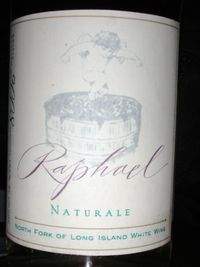 I'm not a "natural wine" disciple by any means. Just like I don't go out of my way to drink organic or biodynamic wines.
I'm not a "natural wine" disciple by any means. Just like I don't go out of my way to drink organic or biodynamic wines.
First and foremost, I want the wine in my glass to be balanced and to taste good.
I don't advocate over-manipulation mind you. We've all had those
over-extracted, over-oaked wines. Parker likes them, but I tend not to.
But, if your Gewurztraminer got a little too ripe and maybe lost a
little too much acid before harvest, I don't begrudge you adding a
little during the winemaking process. I'm not Parker, but I'm not
Feiring either.
Balance. Deliciousness. Those are what matter to me.
If you
make a balanced, delicious wine without the addition of sugar or acid,
without filtration or fining, and using naturally occurring yeasts and
with only the slightest bit of SO2 during bottling, that is worth talking about.
That leads me to Raphael's 2008 Naturale ($20), a blend of 60% chardonnay, 30% sauvignon blanc and 10% semillon that, as the name implies, was made in "natural" way.
Having attended The Art of Balance Symposium
with Rich Olsen-Harbich, Raphael's winemaker, I thought I knew where at
lleast some of the inspiration for this wine came from — Pascal
Jolivet, a staunch believer in natural winemaking who spoke at the
conference.
After talking to Rich a bit, I found out that I was right, at least partially. In an email he told me:
"This was something I think was a slow evolution in my winemaking — from
being comfortable with the flavors and aromas that develop from wild yeast fermentation to the ability to be comfoftable with bottling a white wine with
little sulfur, without filtration. It goes against everything that academia
teaches us about winemaking but that's the whole point. It's kind of like
kissing it up to God and making wine like it was done years ago. Having spent
some time with Pascal Jolivet last summer and talking with him about how he
goes about natural winemaking in the Loire — that's what really inspired me to
try it at Raphael."
Rich has also made a red blend employing the same techniques that will be released in 6 months or so.
Even
if you don't care about the whole "natural winemaking" thing. You
should care about this wine… because it's impressive regardless of
how it's made.
This pale straw blend was bottled about two weeks
ago and has a bit of residual C02 in it that tickles the nose and
tingles the tongue. That slight frizzante is a remnant of fermenation
and Rich think it will disipate within a couple months.
The
nose, especially once the froth subsides and the wine warms to cellar
temperature, is complex and intricate with aromas of ripe Gala apples,
apple blossom, roasted nuts, sweet herbs, lemon zest and toasty yeast.
Medium
bodied, it's much more citrusy on the palate, with the apple taking a
step back, and basil-like herbs, nuts and a subtle minerally note. This
wine is impeccably balanced — creamy on the mid-palate yet featuring
lively acidity. The oak (20% was fermented in new oak, the rest in
stainless) accents rather than dominates. And, the finish is long with
a little yeasty-leesy spiciness.
At $20, it's one of the great values in local white wine. Some local wineries would charge twice that for a wine like this. Only 100 cases were made.
Producer: Raphael
AVA: North Fork of Long Island
Price: $20
Rating:
(4 out of 5 | Delicious, Distinctive
)
